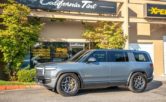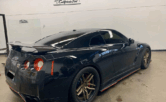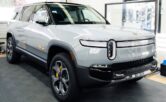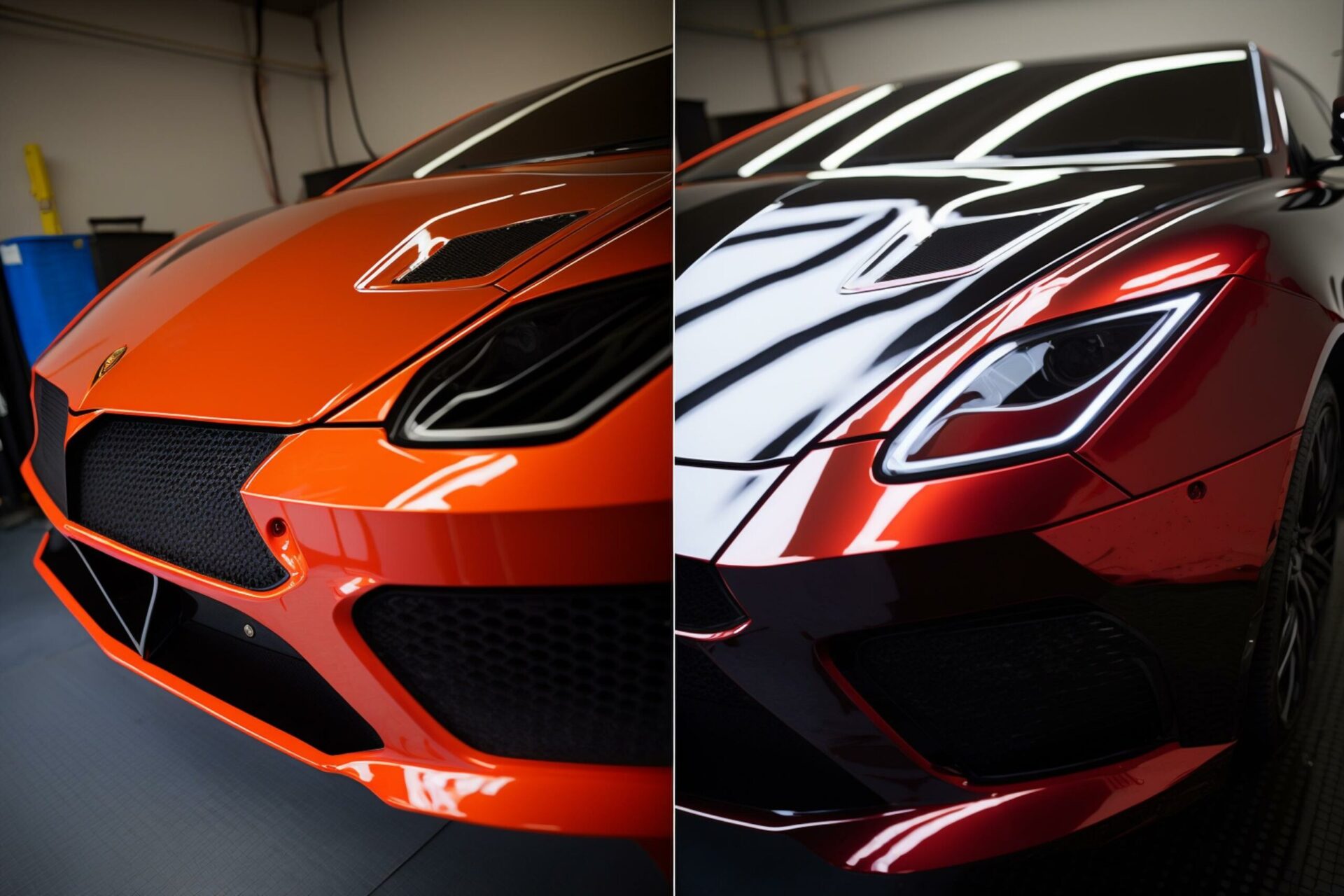
Do I Need Paint Correction Before Installing PPF? A Guide to Making the Right Choice
Understanding the synergy between paint correction and PPF can dramatically enhance your car’s aesthetic and protective qualities. This guide will walk you through key considerations like paint health, vehicle age, and what you aim to achieve with PPF, alongside the value of professional advice. With insights from California Tint, you’re on your way to making an informed decision for your vehicle’s care and protection.
Questions to Consider Before Deciding on Paint Correction
1. What is the Current Condition of Your Car’s Paint?
Before you decide on adding PPF to your car, it’s crucial to inspect your vehicle’s paint. Why? Because the success of PPF largely depends on the paint beneath it.
- Scratches and Swirl Marks: These are not just eyesores. If you apply PPF over them, you’ll lock these imperfections in, affecting how the film sticks and looks.
- Oxidation: This makes your paint look dull and feel rough. Applying PPF over oxidized paint means you’ll seal in the dullness, and the film won’t adhere as well.
A smooth surface is key for PPF. It ensures the film can stick properly, providing seamless protection that enhances your vehicle’s appearance. If you find scratches, swirls, or oxidation, considering paint correction first can make a world of difference. It’s about getting that perfect finish and making sure your PPF does its job well.
2. How Old is Your Vehicle?
The age of your vehicle plays a significant role in determining whether you need paint correction before installing PPF. Here’s a quick breakdown:
- Newer Vehicles: Generally, newer cars have less exposure to the elements and fewer imperfections in their paint. This means they might need minimal to no paint correction before PPF application. However, even new cars can benefit from a detailed inspection to ensure the paint is flawless before adding protection
- Older Vehicles: Age can introduce a range of paint issues, from accumulated scratches and dents to fading and oxidation due to prolonged exposure to the sun and environmental pollutants. Older vehicles often require comprehensive paint correction to restore the paint’s condition. This step is crucial for ensuring the PPF adheres correctly and looks its best.
In essence, the older your vehicle, the more likely it is that paint correction will be a beneficial preparatory step before installing PPF. It’s about creating the ideal canvas for the PPF to do its job effectively, protecting your vehicle’s paint and keeping it looking pristine for years to come.
3. What are Your Expectations for PPF?
Your expectations for PPF can significantly influence whether paint correction should be part of your preparation process. Understanding how durability, appearance, and protection level play into your decision will help you set the right course for your vehicle’s treatment.
- Durability and Protection Level: If you’re seeking the highest level of durability and protection from your PPF, starting with a pristine paint surface is crucial. Imperfections like scratches or swirl marks can compromise the film’s ability to protect your vehicle fully. Paint correction ensures that the PPF can adhere smoothly, offering uninterrupted protection against chips, scratches, and UV damage.
- Appearance: For many, the appeal of PPF is not just its protective qualities, but also how it enhances the car’s appearance. A flawless finish requires a flawless start. Any existing paint flaws will be magnified under the PPF if not addressed. Paint correction removes these blemishes, ensuring the PPF showcases a glossy, smooth surface that turns heads.
If your expectations for PPF include top-tier durability, unparalleled protection, and a stunning appearance, then paint correction is an essential preparatory step. It ensures that your investment in PPF meets your expectations and that your vehicle looks as good as it is protected.
4. Have You Considered the Long-Term Benefits of Paint Correction?
Paint correction offers significant long-term benefits that extend beyond just creating a perfect base for PPF. It’s an investment in your vehicle’s appearance and preservation that pays off in multiple ways.
- Enhanced Gloss and Aesthetics: Paint correction revitalizes your vehicle’s paint by eliminating surface imperfections, revealing a glossy, smooth finish. This enhanced appearance is preserved under the PPF, showcasing your vehicle’s beauty long term.
- Protection of Original Paint: Beyond aesthetics, paint correction also provides a protective benefit to your vehicle’s original paint. By removing defects and sealing the paint, you’re protecting it from further damage and oxidation, helping maintain the vehicle’s value.
- Longevity of PPF: The lifespan of PPF is directly influenced by the condition of the surface it adheres to. A well-prepared, corrected paint surface ensures optimal PPF adhesion, reducing the risk of peeling, bubbling, or lifting. This means your PPF will perform better and last longer, providing durable protection against the elements, road debris, and minor impacts.
Investing in paint correction before applying PPF not only enhances your car’s current appearance, but also contributes to its long-term preservation and protection. This preparation step ensures that your PPF application is as effective and enduring as possible, safeguarding your investment in your vehicle’s aesthetic and structural integrity.
5. What is Your Budget?
Budget considerations play a pivotal role in deciding whether to opt for paint correction before PPF installation. Understanding the cost implications and potential long-term savings can help you make an informed decision.
- Initial Cost Implications: Paint correction is an additional expense on top of PPF installation. The cost can vary based on the car’s size, the extent of the damage, and the level of correction required. While it may seem like an extra upfront cost, it’s important to consider the value it adds by ensuring the PPF adheres properly and looks its best.
- Long-Term Cost Savings: Investing in paint correction before PPF installation can lead to significant savings down the line. A well-maintained paint surface under PPF is less likely to need expensive paint jobs or touch-ups in the future. The PPF itself protects the paint from scratches, UV damage, and minor abrasions, which means less maintenance and repair costs over the lifespan of your vehicle.
- Preservation of Vehicle Value: Beyond the immediate cost savings on maintenance and repairs, a vehicle with well-preserved paint and bodywork retains its value better over time. When it’s time to sell or trade in your vehicle, a flawless exterior can significantly enhance its resale value.
While paint correction adds to the initial investment in PPF, the benefits of a better-looking finish, reduced maintenance costs, and preserved vehicle value offer a compelling argument for considering this preparatory step as part of your overall vehicle protection strategy.
Flexible Budget Solutions: Tailored Paint Correction Services for Every VehicleBudget considerations are crucial when deciding on paint correction before PPF installation. California Tint offers three levels of paint correction services (one-step, two-step, and three-step correction), designed to meet the needs of cars at different stages of wear, from nearly new to older vehicles with severe paint defects. This tiered approach allows for flexibility in cost and service level, ensuring that there is an option that fits both your vehicle’s needs and your budget. |
The Professional’s Role in Your Decision
Deciding whether to opt for paint correction before installing PPF involves several considerations, from assessing the current state of your vehicle’s paint to understanding your long-term protection goals. This is where the expertise of a professional becomes invaluable, especially with California Tint’s seven years of experience in delivering outstanding paint correction results, emphasizing their expertise in reviving a car’s color and showcasing its beauty.
- Clarity and Expertise: A professional assessment can demystify the process, offering clarity on the exact condition of your paint and what steps are necessary to achieve your desired outcome. Professionals use their trained eye and specialized tools to detect issues that might be invisible to the untrained eye, ensuring that no detail is overlooked.
- Tailored Advice: Every vehicle is unique, and so are the expectations of each owner. Professionals at California Tint provide tailored advice based on the specific needs of your vehicle and your personal preferences. They can guide you through the options, explaining the benefits and potential drawbacks of each choice, helping you make an informed decision that aligns with your budget and goals.
- Ensuring the Best Outcome: The goal of any PPF installation is to protect and enhance the appearance of your vehicle. Professionals ensure that the process, from paint correction to PPF application, is executed flawlessly. Their expertise not only guarantees the best aesthetic outcome but also maximizes the protective benefits of PPF, ensuring durability and longevity.
Simplify Your Decision with California Tint
Deciding if you need paint correction before PPF installation can be complex. At California Tint, we simplify this decision for you. Our experts assess your vehicle’s needs, ensuring you get the right services for optimal protection and appearance. If you’re unsure, trust California Tint to guide you. Contact us today to ensure your vehicle not only looks great, but is protected with precision.
- PPF vs Ceramic Coating For Your Rivian: Which Is Right For You? - September 18, 2025
- DIY PPF Vs PPF Installers: What Can Go Wrong? - September 8, 2025
- Why Rivian Owners Are Choosing PPF: Protecting Your R1T or R1S from the Elements - August 8, 2025
